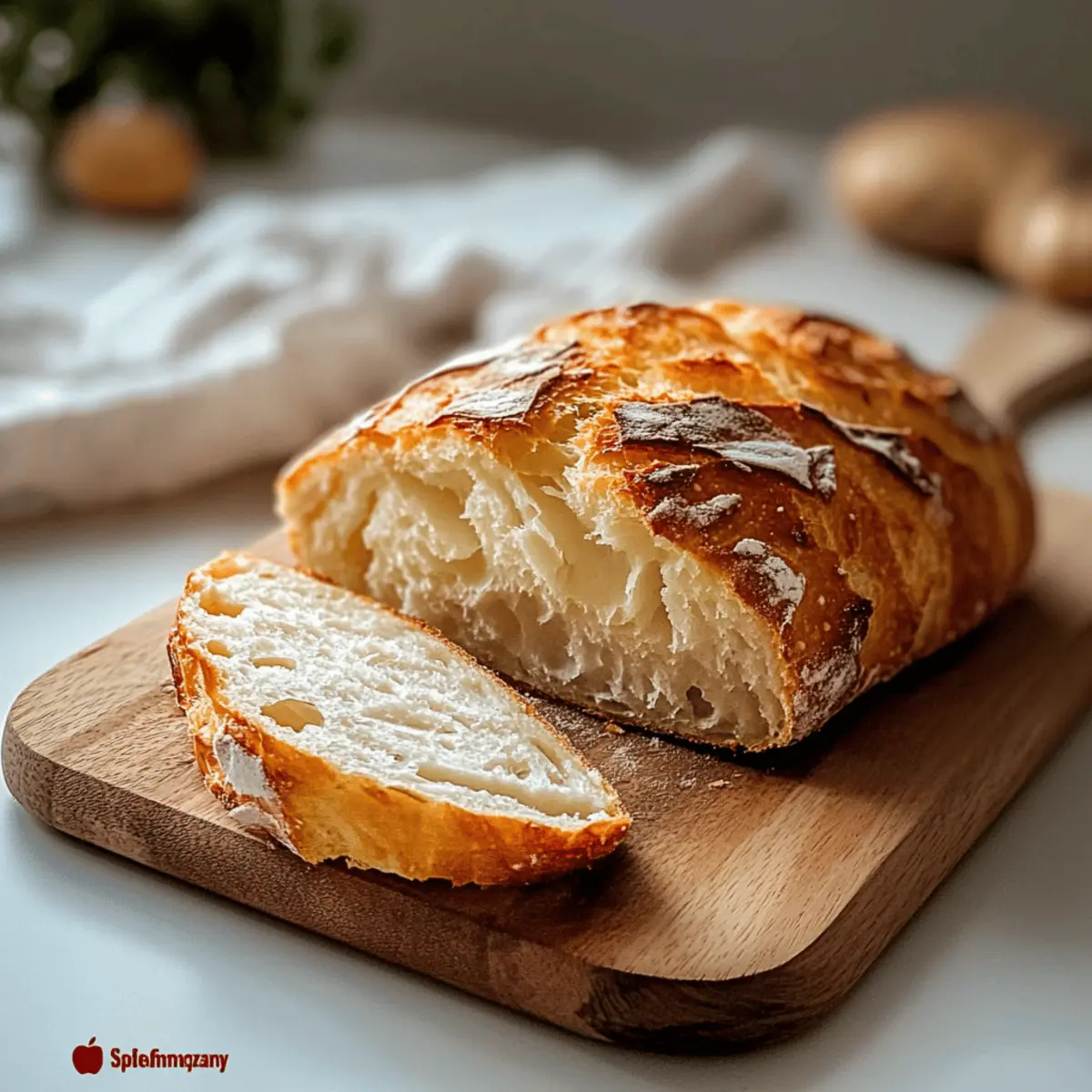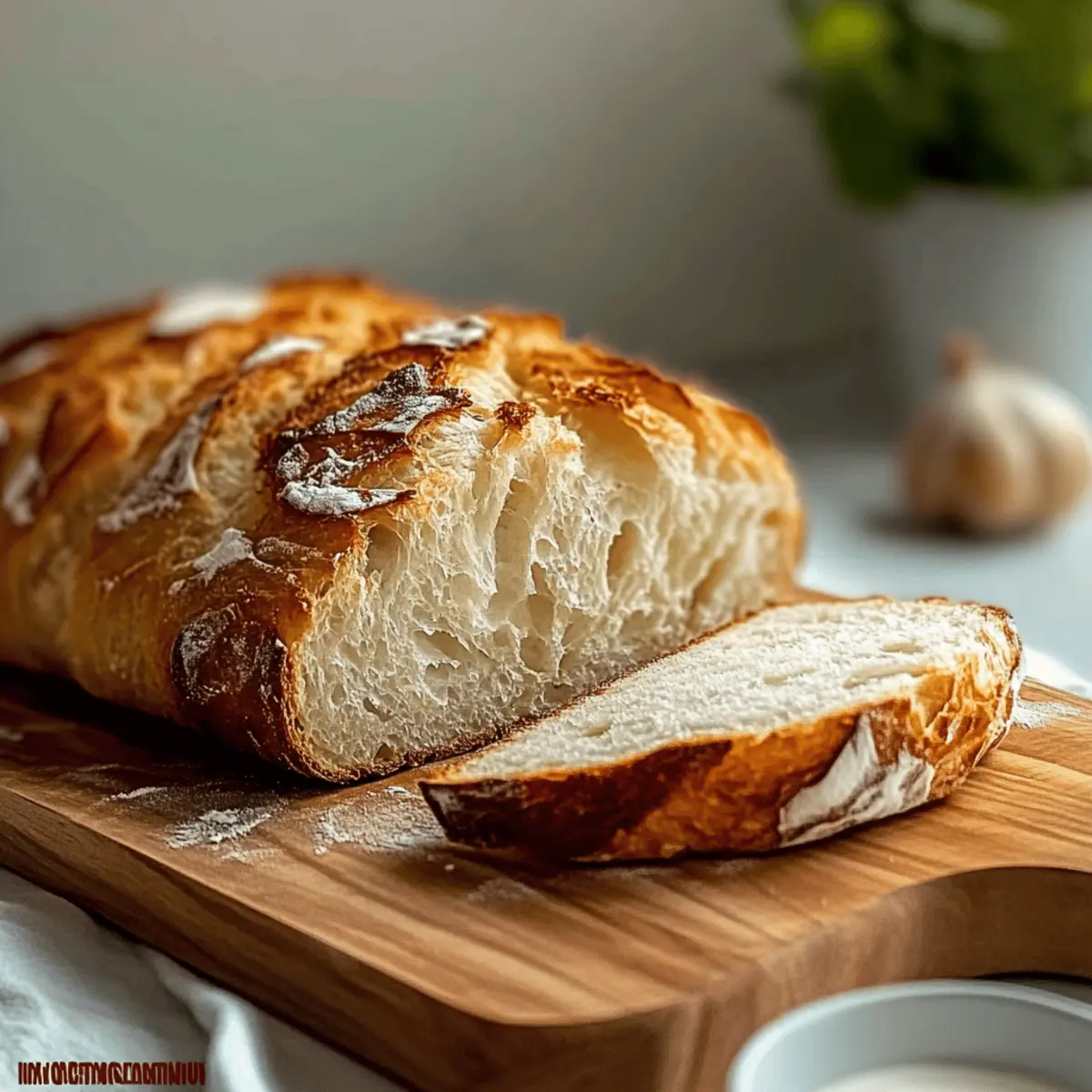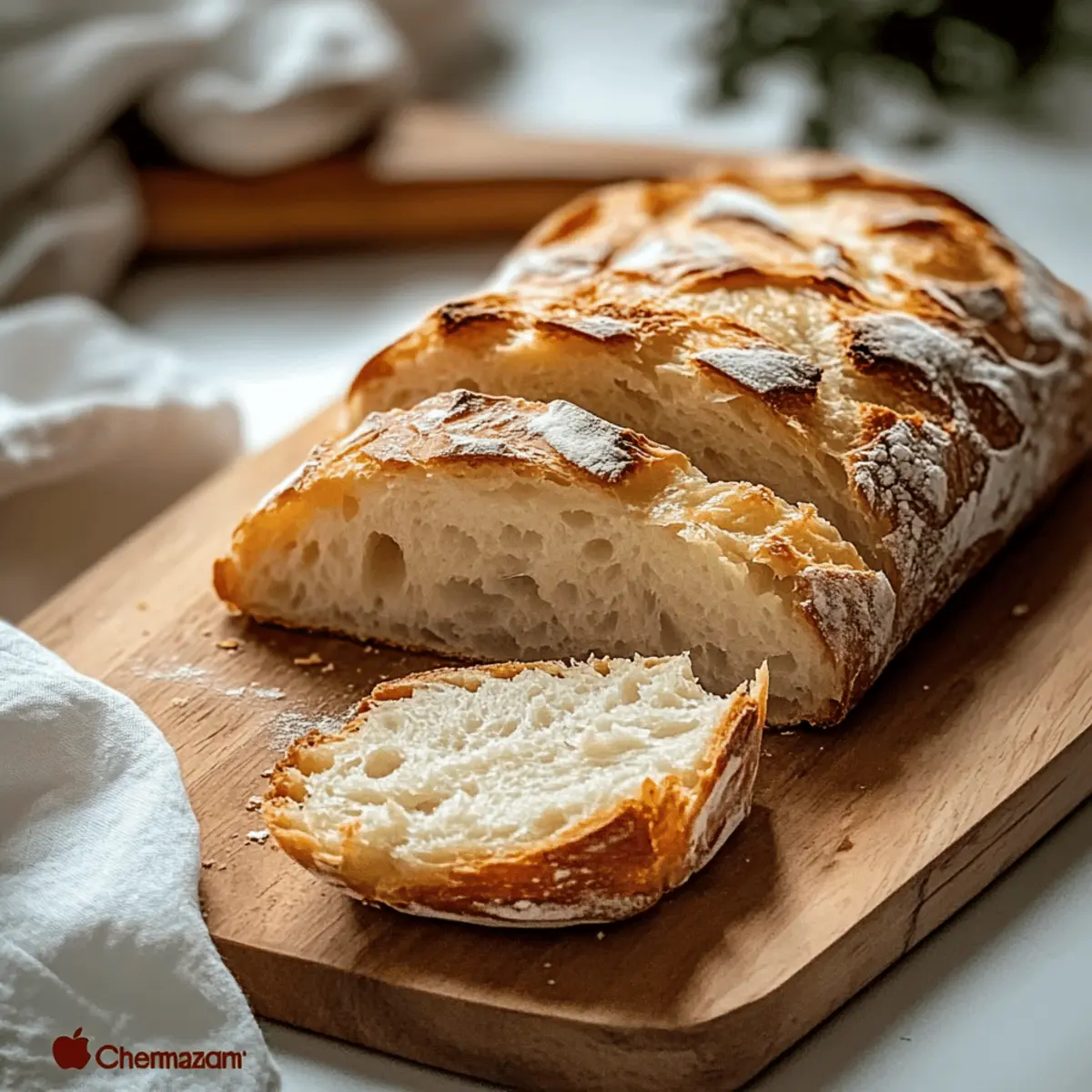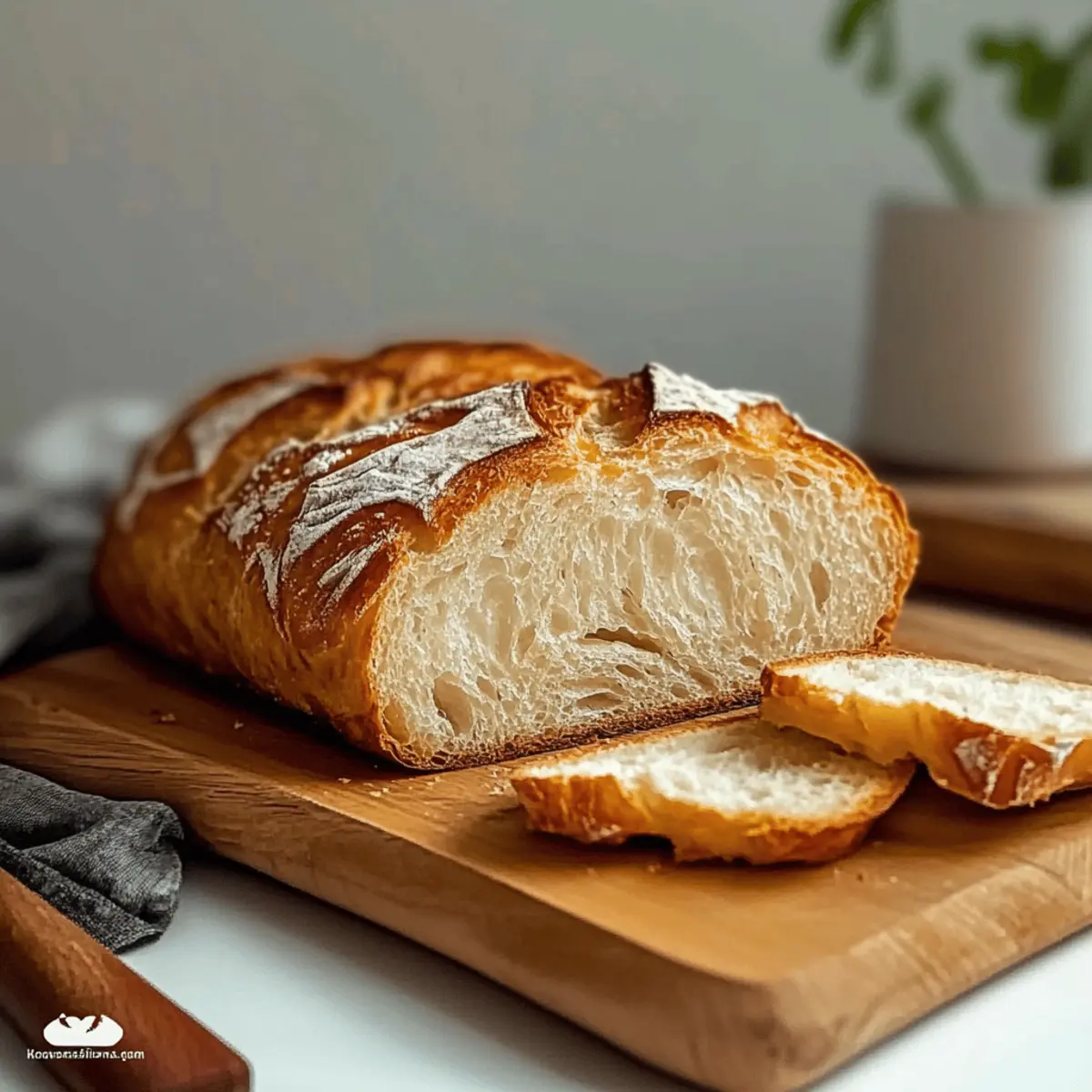The aroma of freshly baked bread wafts through my kitchen, transporting me back to my grandma’s Polish home, where Chleb Ziemniaczany—Polish Potato Bread—was a staple at every meal. This delightful bread, enriched with leftover mashed potatoes, boasts an incredibly soft and moist crumb that makes it impossible to resist. Not only is this traditional recipe easy to whip up, but it also helps minimize food waste by giving a second life to those unloved potatoes lingering in your fridge. Whether you’re crafting a savory sandwich or savoring a warm slice with butter, every bite of this comforting loaf is a reminder that home-cooked meals nourish not just the body, but the soul. Are you ready to bring a touch of Polish heritage to your own table? Let’s get started!
Why is Polish Potato Bread so special?
Comforting Tradition: Polish Potato Bread, or Chleb Ziemniaczany, is more than a recipe; it’s a journey through memories and culture.
Easy to Make: This recipe is perfect for both novice and experienced bakers with just a few simple steps.
Versatility: Enjoy it as toast, in sandwiches, or even as a side for soups like żurek—this bread does it all!
Waste Not, Want Not: Utilizing leftover mashed potatoes not only reduces food waste but also adds delightful moisture to your loaf.
Modern Twists: Feel free to experiment with variations like Cheesy Potato Bread or Herbed Potato Bread for a unique spin!
Polish Potato Bread Ingredients
For the Dough
- Russet Potatoes – Provide moisture and starch for tenderness; use well-mashed or riced potatoes to avoid lumps.
- Dry Yeast – Essential for dough rising; ensure it’s fresh and active for best results.
- All-Purpose Flour – The bread’s structural base; can substitute half with whole wheat for added fiber.
- Salt – Enhances flavor and balances sweetness from the potatoes; vital for the overall taste of the bread.
- Water – Activates yeast and helps form the dough; use lukewarm water for best results.
For Optional Variations
- Fresh Herbs – Fold in herbs like rosemary, thyme, or dill to create Herbed Potato Bread.
- Shredded Cheese – Incorporate cheese such as cheddar or parmesan for a delicious Cheesy Potato Bread.
- Gluten-Free Flour – Use a mix of almond flour and gluten-free flour for a gluten-free adaptation.
Embrace the delightful journey of creating Polish Potato Bread with these carefully selected ingredients that promise a delicious and satisfying experience!
Step‑by‑Step Instructions for Polish Potato Bread
Step 1: Prepare Potatoes
Begin by peeling and cutting 3-4 Russet potatoes into chunks. Boil the potatoes in salted water for about 15-20 minutes, or until they are tender and easily pierced with a fork. Drain the potatoes, mash them until smooth, and allow them to cool to room temperature. This step is crucial for achieving the soft texture characteristic of Polish Potato Bread, also known as Chleb Ziemniaczany.
Step 2: Mix Dough
In a large mixing bowl, combine the cooled, mashed potatoes with 1 packet of dry yeast, 1 cup of lukewarm water, and 1 teaspoon of salt. Stir gently to mix the ingredients until well combined. Gradually add 3-4 cups of all-purpose flour, mixing until the dough begins to form and pulls away from the sides of the bowl. This mixture should come together into a soft, slightly sticky dough that is ready for kneading.
Step 3: Knead
Transfer the dough onto a floured surface and knead it for about 8-10 minutes. During this time, work the dough until it becomes smooth and elastic, which is essential for creating the perfect texture in your Polish Potato Bread. If the dough feels too sticky, sprinkle a little more flour as needed. Aim to form a cohesive ball that springs back when gently poked.
Step 4: Proof
Place the kneaded dough into a greased bowl, making sure to coat the top with a light layer of oil. Cover the bowl with a clean kitchen towel or plastic wrap, and let it rise in a warm area for about 1-2 hours. The dough should double in size—look for it to puff up and become airy, indicating that the yeast is actively working its magic in your Chleb Ziemniaczany.
Step 5: Shape & Second Proof
Once the dough has risen, gently punch it down to release any air bubbles. Turn it out onto a lightly floured surface and shape it into a loaf. Place the formed loaf into a greased bread pan, ensuring it fits snugly. Cover it again and allow it to rise for an additional 30-60 minutes until it noticeably increases in size, which helps achieve that lovely softness in your Polish Potato Bread.
Step 6: Bake
Preheat your oven to 375°F (190°C) while the dough is undergoing its second proof. Once preheated, place your bread pan in the oven, and bake for 30-40 minutes. Keep an eye on the bread; it should develop a golden-brown crust and sound hollow when tapped on the bottom. This is the perfect time to savor that delightful aroma of freshly baked Polish Potato Bread wafting through your kitchen!
Step 7: Cool
Remove the bread from the oven and let it cool in the pan for about 10 minutes. After it has cooled slightly, carefully transfer the loaf to a wire rack to cool completely. This cooling process is essential to maintain the bread’s soft, moist texture. Your Polish Potato Bread is now ready to be sliced and enjoyed in various ways, whether as toast, sandwiches, or simply with butter!
Variations for Polish Potato Bread
Feel free to get creative with your Polish Potato Bread and make it your own—with flavors and textures that your family will love!
-
Whole Wheat Version: Substitute half of the all-purpose flour with whole wheat for a heartier loaf full of fiber. This simple swap offers a nuttier flavor and denser texture that adds a delightful twist to the classic.
-
Herbed Potato Bread: Fold in fresh herbs like rosemary, thyme, or dill for a fragrant touch. Adding herbs offers a burst of flavor, transforming your loaf into a delicious companion for soups or a standout in your sandwich creations.
-
Cheesy Potato Bread: Incorporate shredded cheese such as cheddar or parmesan into the dough for a cheesy delight. The melty goodness of cheese throughout the bread adds a rich taste that complements sweet and savory toppings alike.
-
Gluten-Free Adaptation: Use a mix of almond flour and gluten-free flour for a delicious gluten-free option. This allows everyone to enjoy a soft slice without compromising on flavor, making it accessible for those with dietary restrictions.
-
Sweet Potato Twist: Swap out regular potatoes with sweet potatoes for a subtly sweet variation. The natural sweetness makes it perfect for breakfast or brunch, especially paired with a drizzle of honey or maple syrup.
-
Spicy Addition: Mix in finely chopped jalapeños or red pepper flakes for a kick of heat. This fiery twist not only enhances the flavor but also makes the bread an exciting addition to your meals, especially tacos or grilled meats.
-
Seed Studded Loaf: Add a mix of sunflower, pumpkin, or sesame seeds into the dough for added texture and nuttiness. This will not only enhance the aesthetic appeal with a crunchy topping but also provide extra nutrients and a delightful bite.
-
Garlic Infusion: Incorporate roasted garlic into the dough for a savory depth of flavor. The sweet, caramelized notes of garlic will elevate your loaf to new delicious heights, making it a perfect companion for your favorite spreads.
With these variations, you can easily customize your Polish Potato Bread to suit the tastes of your household. If you’re looking for other delightful potato dishes, consider trying Cheesy Garlic Potato Bake or Potato Taco Bowls for even more delicious inspiration!
How to Store and Freeze Polish Potato Bread
Room Temperature: Store unused Polish Potato Bread in an airtight container or wrapped in plastic wrap at room temperature for up to 3 days to maintain freshness.
Fridge: If you live in a warm climate, refrigerate the bread for up to 5 days. Wrap it well to prevent it from drying out.
Freezer: For longer storage, slice the bread and freeze it in a freezer bag for up to 3 months. To enjoy, toast directly from frozen or thaw at room temperature.
Reheating: When reheating, place slices in a toaster or warm them in the oven for a few minutes to regain that inviting texture and aroma.
Expert Tips for Polish Potato Bread
-
Use the Right Potatoes: Choose starchy Russet potatoes for the best texture; they provide the moisture needed for a soft crumb in your Polish Potato Bread.
-
Check Yeast Freshness: Always ensure your dry yeast is fresh and active; proof it in warm water before mixing to guarantee a good rise.
-
Avoid Over-kneading: Knead until the dough is smooth and elastic, about 8-10 minutes. Over-kneading can lead to a tough loaf rather than the desired tenderness.
-
Temperature Matters: Allow the dough to rise in a warm place. Cold air can slow down yeast activity, preventing proper rising.
-
Cool Before Slicing: Be patient and let the bread cool completely on a wire rack; this ensures that the loaf retains its soft texture when sliced.
What to Serve with Polish Potato Bread
The aroma of freshly baked Polish Potato Bread is the perfect backdrop for crafting a wholesome and satisfying meal.
- Creamy Soup: Pair with a velvety bowl of żurek; the sourness beautifully complements the bread’s soft texture.
- Herbed Butter: Spread a mixture of soft butter and fresh herbs; it elevates each slice, bringing out the potato’s rich flavor.
- Charcuterie Plate: Complement with cold cuts and cheeses for a delightful mix of savory, creamy, and salty flavors that enhance the bread.
- Fresh Salad: Serve alongside a crisp cucumber and tomato salad; it’s refreshing and provides a lovely contrast to the warm bread.
- Cheesy Eggs: Enjoy with scrambled eggs mixed with your favorite cheese, creating a hearty breakfast that will warm your soul.
- Pickled Vegetables: Serve with tangy pickles to add a burst of flavor, cutting through the bread’s richness for a satisfying bite.
- Homemade Jam: Top warm slices with seasonal fruit jam; the sweet and savory combination is simply irresistible.
- Black Tea or Coffee: Sip a warm cup alongside; the richness of the drink enhances the comforting nature of the Polish Potato Bread.
- Roasted Vegetables: Pair with a medley of roasted veggies for a colorful, nutritious dish that contrasts nicely with the soft bread.
- Apple Crisp: For dessert, enjoy a warm slice of apple crisp; its spiced sweetness complements the bread beautifully and feels like a warm hug.
Make Ahead Options
Polish Potato Bread is a fantastic choice for meal prep, helping you save time during busy weeknights! You can prepare the dough up to 24 hours in advance; simply follow the steps until the first proof, then cover the bowl tightly with plastic wrap and refrigerate it. This slow chilling allows the flavors to deepen, ensuring your bread is just as delicious. When ready to bake, let the dough come to room temperature for about 30 minutes before shaping and proceeding with the second proof. Additionally, you can slice the baked bread and store it in an airtight container for up to 3 days or freeze for up to 3 months. Your Polish Potato Bread will remain soft and delightful, ready to be enjoyed with minimal effort!
Polish Potato Bread Recipe FAQs
What type of potatoes should I use for Polish Potato Bread?
I highly recommend using Russet potatoes for this recipe. Their high starch content provides excellent moisture and tenderness, resulting in that soft crumb we all love. Make sure to mash or rice them until smooth, avoiding any lumps for a perfect texture!
How should I store leftover Polish Potato Bread?
To keep your delicious Polish Potato Bread fresh, store it in an airtight container at room temperature for up to 3 days. If you live in a warmer climate, you might want to refrigerate it for up to 5 days—just ensure it’s well-wrapped to prevent drying out.
Can I freeze Polish Potato Bread?
Absolutely! For freezing, slice the bread and place it in a freezer bag, making sure to remove as much air as possible. It will stay good for up to 3 months. When you’re ready to enjoy it, simply toast the slices from frozen or let them thaw at room temperature.
What should I do if my dough doesn’t rise?
If your dough hasn’t risen after the proofing time, this could be due to inactive yeast. Ensure your yeast is fresh and try proofing it in warm water first before mixing. If the dough is still flat, you can add a bit more warm water and a pinch of sugar to help activate the yeast.
Are there any dietary considerations I should be aware of?
Yes! While Polish Potato Bread is generally safe for most diets, those following gluten-free diets can adapt the recipe by using a gluten-free flour blend. Always check for potato allergies as well; though rare, it’s important to be mindful of individual sensitivities.
How can I make this recipe healthier?
For a healthier twist, consider substituting half of the all-purpose flour with whole wheat flour. This will not only add fiber to your Polish Potato Bread but also give it a nutty flavor that complements the potatoes beautifully!

Irresistibly Soft Polish Potato Bread for Comforting Meals
Ingredients
Equipment
Method
- Prepare Potatoes: Peel and cut Russet potatoes into chunks. Boil for about 15-20 minutes until tender. Drain and mash until smooth. Cool to room temperature.
- Mix Dough: In a large bowl, combine cooled mashed potatoes with dry yeast, lukewarm water, and salt. Stir gently, then gradually add flour until the dough pulls away from the sides.
- Knead: Transfer dough to a floured surface and knead for 8-10 minutes until smooth and elastic. Add more flour if too sticky.
- Proof: Place dough in a greased bowl, cover, and let rise in a warm area for 1-2 hours until doubled in size.
- Shape & Second Proof: Punch down dough, shape into a loaf, place in greased pan, cover, and let rise for an additional 30-60 minutes.
- Bake: Preheat oven to 375°F (190°C). Bake for 30-40 minutes until golden brown and sounds hollow when tapped.
- Cool: Let bread cool in the pan for 10 minutes, then transfer to a wire rack to cool completely.




